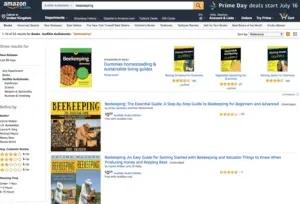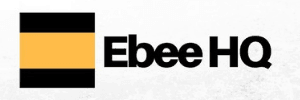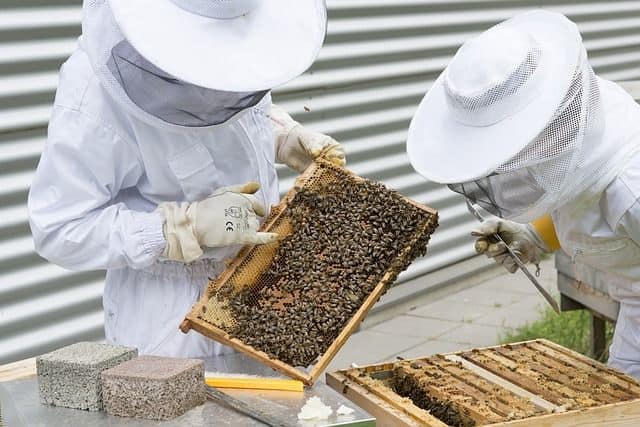Last Updated: 23 July 2024
Humans have been keeping bees for thousands of years. We first domesticated bees in Ancient Egypt and harvested them for their honey. One of the world’s most healthy foods and the most nutritious sweetener is honey, so it was easy for the practice to spread all over the world.
Beekeeping is a fascinating and profitable activity, but before you get into beekeeping, you must consider the first and foremost issue: bee sting. If you or someone in your family has allergies to bee stings, beekeeping might not be the best choice. Even though honeybees are not aggressive creatures (they only sting in self-defense), chances are that you will eventually get stung.
What is Beekeeping
Beekeeping has become a popular hobby because it can be very rewarding. Do you know why?
Well, the most popular reason is that you can produce your own honey. Imagine getting your all-natural, 100% honey straight from the hive.
Besides honey, your busy bees will also give you other products, such as beeswax and royal jelly. Beeswax can be used to make candles and cosmetics, and royal jelly is a valuable dietary supplement.
I know that it all sounds great and seems like a very interesting hobby, but you must be sure you are going to be a responsible beekeeper before starting a bee farm. Hony bees are not something you can just get tired of and leave forgotten in your backyard. Beekeeping requires commitment, a responsibility that will be rewarded, of course, but still a commitment.
Here are 5 steps you MUST take before you can become a beekeeper:
Becoming a beekeeper
1. The cost and time factor
The first thing you will need is to learn about bees and beekeeping. You will need to invest a little money in books and courses, you can find these course on Amazon, I’ve. This is your first necessary step. If you just start by buying a hive and some bees and try to learn as you go, chances are that you could ruin your colony.
You will, of course, keep learning as you go once you have started, but for the beginner beekeeper the first necessary step, before doing anything else, is read and learn, we’ve provided some necessary sources below.
Now, Amazon Audible is currently running a 30-day free trial of the Audible service, which means that you can sign up for 30 days, listen to one of our recommended beekeeping audiobooks, entirely for free.
If you’re interested,
Click on the following link [30-day Free Trial – Beekeeping Audiobooks] to and you will see that all of the audiobooks are $0.00 (part of the Audible Free Trial deal) all you need to do is add one to your basket and follow the process, and start reading… listening I mean.

We recommend taking a look at this fantastic audiobook, which can also be purchased as a physical book, or ebook depending on your preference: A step-by-step guide to beekeeping by Andy Jacobson
We’re recommending Audiobooks, as they are an awesome way to listen to the material, whilst allowing you to get on with your busy lives.
This material will help not only teach you more information about the subject of beekeeping, but it will spark your enthusiasm for the hobby.
2. Inform your neighbors
Let them know you are planning on starting beekeeping. You don’t want to disturb anybody so you specifically want to check if any of your neighbors have allergies to bees. That can be an issue. Besides allergies, many people are afraid of bees because of the misconception that they are dangerous and always ready to sting. The best thing to do in that case is not only to inform your neighbors but also to educate them about bees and what beekeeping is.
3. Choose where you will keep your hive
Where bees are kept is called an apiary or bee yard and does not need to be very spacious. You can keep them in a small backyard or even on the rooftop or in a balcony.
All you need is an area for your hive that will not disturb anyone and a nearby water source. You don’t even need to have your own garden.
The location of the hive will affect the productivity and health of your honeybees. So if you can find a place that fits the criteria for an optimal hive placement, it’ll be much better for your bees.
Legal restrictions
This is another thing to consider, especially if you live in an urban area. Restrictions on beekeeping are becoming rarer (you can even keep bees in NYC). However, you need to check with your local authority or council before you begin. In many communities, you must be registered as a beekeeper in order to perform your activity legally.
Startup equipment
Besides books and courses, you will need to buy a hive, honey bees and some basic beekeeping equipment and supplies for your bees.
Once this initial investment is made, maintenance costs are low. You will also need to buy queens, medication, and food. Remember, selling part of your honey production can cover these expenses.
Here is the beekeeping equipment deemed necessary:
Beehive
This is the most important piece of equipment, being the new home for your bees and the foundation of your honey production.
Take a look at our lists of recommended beehives for sale and beekeeping starter kits.
Bee Smoker
A bee smoker is used to calm the honeybees. Smoke has been used to calm bees since ancient times. It masks the alarm pheromones that guard bees release to warn the colony of an interloper. Various things can be used to fuel it, like cartons, pine needles or wood. There are commercial fuels made from pulped paper or compressed cotton.
Bee Suit
The suit is used to protect you from bee stings. It is supposed to cover your entire body. Some bee suits have an integrated hat and veil and others have this separate. If you don’t have a proper bee suit, then you can easily use a makeshift one. Just remember to use thick fabrics and close all the openings but use a see-through fabric for your veil. Some beekeepers go without any protection but it’s not good to tempt fate.
Take a look at our list of recommended beekeeping suits.
Hive Tools
These are specially designed levers used to dismantle beehives or remove frames from hives in order for the beekeeper to inspect the colony. It is also used to get rid of excess brace comb in the hives. Hive tools are flat metallic bars with a broad flat hook at the end. Of course, any flat bar, like a knife, will be alright.
Bee Brush
These are used to brush bees off from any surface, like your bee suit or your hive frames. They are particularly needed when it’s finally time to take some honey. Bees tend to cluster near it and you’ll just have to brush them off. Bee brushes have long and soft bristles in order to shoo bees away without hurting them.
Queen Catcher
Sometimes, you’ll want to capture the queen bee. Most beekeepers do so in order to mark them and keep tabs on their age. A queen catcher makes this easier. It looks like a hair clip.
Queen Muff
Capturing the queen alone is hard. You will normally see her with a lot of bee attendants surrounding her. A queen muff will help you isolate the queen from the other bees, once she is captured.
Honey Extractor
This bee equipment extracts the honey from the hive. Extracting honey can be done through other means, but if you have a lot of hives then this really becomes more of a necessity.
Take a look at our list of recommended honey extractors.
Types of Beehive
The first important decision for you to make when starting beekeeping is choosing a beehive for your bees. Although you will see many different types of beehives, all of them are variations of two main categories of hives: The Langstroth Hive and the Top Bar Hive.
The Langstroth Hive
It takes its name from Lorenzo Langstroth, a reverend who, back in 1851, discovered that honeybees always allow a 3/8 “ space between combs (bee-space). If the space is bigger, the bees will build combs and if it is smaller they will fill it with propolis. Knowing this he was able to make a major improvement in the construction of beehives.
His beehive was constructed with frames that hung from the top ends of the hive, leaving a 3/8” space between all sides of the frames and the hive body. These frames were very easy to handle without breaking the combs.
Top Bar Hives
Top bar hives, also known as foundationless hives, offer a lot of advantages for beekeepers. It utilizes the bees’ natural flow and ability to create their own combs without interference.
Bees are encouraged to create wax comb to hang from a single bar of wood. The bees are allowed to freely construct the wax comb, unlike in a Langstroth hive where a four-sided frame is used to guide the bees.
This may result in lesser honey being produced, but the clear yellow comb that you harvest is of better quality and highly regarded by some people over liquid honey. Due to the absence of reinforcements, the combs are easy to remove during harvesting. An extractor is not necessary.
The Warre Hive
The Warre beehive is constructed to reflect the natural positions chosen by wild bees. It’s smaller than the Langstroth hive and is easier to manage compared to other hives. It is perfect for busy hobbyists who don’t interact with their bees frequently.
The British Standard National beehive
This type of beehive follows the UK standards for hives. It is usually found in the United Kingdom and is so much more affordable and easy to assemble. It is more suitable for more productive bees and is an alternative to Langstroth.
The Basics of Raising Bees: Bee Society
Now that you’re all set to get started, and you’ve learnt more about what exactly beekeeping is, you need to understand how the “bee society” works. Beekeeping is a process that preserves the health of all the different bees in a hive. Getting to know the different bees is an important step in order to keep a bee colony healthy.
Bees are social creatures. They don’t live alone but in hives where everybody has a task. Together they gather food, take care of their young, and protect the hive. A single colony can have a population of about 70,000 bees. It’s composed of one queen, hundreds of drones and thousands of workers.
Queen
A hive revolves around the queen. She is the only bee able to reproduce. Once in her life, she mates with a drone. This period lasts for a few days and as many as 15 drones may mate with a young queen. She stores all the sperm inside her and releases it every now and then for the rest of her life (up to 7 years) in order to continuously lay eggs. A healthy queen can lay 2 thousand eggs a day.
Workers
The worker bees are the highest numbers in a hive. While the queen reproduces, the worker does all the daily chores, like sealing honey, feeding the drones, raising bees and larvae, attending to the queen, building honeycombs, storing pollen, covering with propolis, removing dead bees and larvae, cooling the hive, guarding, carrying water and foraging. They mature in 21 days and live for about six weeks.
Drones
These are male honey bees. They grow from unfertilized eggs and only have a single set of genes, unlike the workers and queen. Drones are only raised when resources are plentiful. In times of hardships like winter, they are the first to be driven out. They have only one purpose to mate.
Conclusion
Once you discover the magic of beekeeping you won’t be able to stop wanting more.
You will be continually learning about bees and their nature, and the more you learn, beekeeping will become even more fascinating.
If you do decide to begin beekeeping, take a look at our article on how to start a beehive.
We hope that you’ve found this article useful, on the topic of what is beekeeping.



What an informative article – particularly the names of hive types. Thanks for a great article.
Not a problem, thank-you very much for featuring us on your website. I will mention and link to your article within our Urban Beekeeping article! 😀